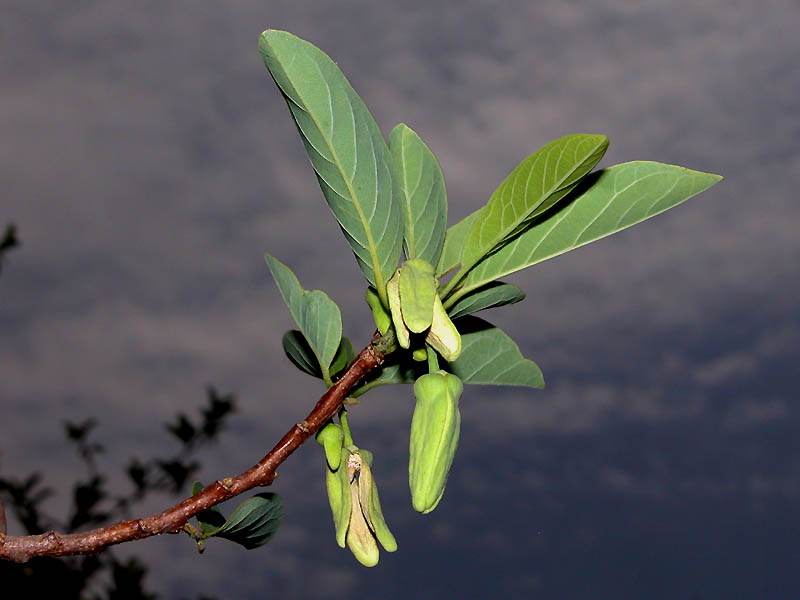
Annona squamosa L. - sugar apple

Annona squamosa L. - sugar apple

Annona squamosa L. - sugar apple

Annona squamosa L. - sugar apple

Annona squamosa L. - sugar apple

Annona squamosa L. - sugar apple
| Plant Category | : | Tree |
| Melghat's Flora's Serial No. | : | 2 |
| Synonym | : | Annona asiatica L.;
Annona asiatica Vahl;
Annona cinerea Dunal;
Annona distincta Raeusch.;
Annona forskahlii DC.;
Annona forsskalii DC.;
Annona glabra Forssk.;
Annona squamosa Delile ;
Guanabanus squamosus M. Gómez;
Xylopia frutescens Sieb. ex Presl; Xylopia glabra L.; |
| Plant Common Name | : | Sitaphal, Sugar Apple, Custard apple • Hindi: Sharifa, Sitaphal • Manipuri: Sitaphal • Assamese: Katal • Tamil: Sitapalam • Marathi: Sitaphal
|
| Plant Family | : | Annonaceae |
| Description | : | a small deciduous tree about 3-5(-6) m tall, produces its first branches near the base of the trunk. The branches are irregularly spreading and the young growth is densely pubescent. The leaves are alternate, ovate-oblong or elliptic-oblong, thin, sparsely downy, dark green above, 8-15 cm long and 2-5 cm wide. When young, leaves are pubescent and give a peculiar smell when crushed. The petiole is about 1.0-1.5 cm long. The small, pendulous flowers occur singly or in pairs in the leaf axils of young shoots or opposite the leaves. The pedicel is 1.5-2.5 cm long and hairy. The three sepals are short, deciduous, densely or thinly pubescent, and 0.2-0.3 cm long. The 6 petals are biseriate. The three outer petals are lanceolate, thick, fleshy, trigonous, finely pubescent, yellowish-green on the outside, yellowish-white inside, 2.0-2.5 cm long and 0.5-1.0 cm wide. The three inner petals alternate with the outer ones and are minute, sometimes absent, ovate and never more than 0.1 cm long. The stamens are numerous, yellowish-white in many rows on the glabrous, raised receptacle (torus), 0.12-0.15 cm long and crowded in a whorl around the gynoecium. The pistils are also numerous, dark violet, finely pubescent, and are found above the stamens. The stigmas are sessile, stuck together, and deciduous. The stamens and pistils form a cone-shaped structure at the centre of the flower. The fruit is a syncarp developed from the fusion of numerous ovaries. It is irregularly heart-shaped, about 5-20 cm in diameter. The exterior is marked by polygonal tubercles which correspond to the fused carpels from which the fruit is formed. The ripe fruit is light yellowish-green or purple and the exterior readily separates along the lines between the tubercles. The flesh is white, soft and juicy with a mild, agreeable flavour. The numerous seeds are obovoid or elliptic, dark brown or black, shiny, slightly compressed, 1.0-1.5 cm long and 0.5-0.8 cm wide, and each is enclosed in the edible pulp. |
| Plant Location in Melghat | : | Common on foot hills |
| Medicinal Use / Activity | : | The plant is traditionally used for
the treatment of epilepsy, dysentery, cardiac problem, worm infection, constipation,hemorrhage, anti-bacterial infection, dysuria, fever, and ulcer. It also has antifertility, antitumor and abortifacient properties. Breast Cancer, Seed : Malignant Sores(cancer); The green fruits, seeds and leaves have effective vermicidal properties. The young shoots, combined with peppermint, are used in the West Indies to relieve colds and chills. |
| Plant's Phytochemicals | : | COMPOUNDS: Squamocin; Squamostatin; squamocin-O1; squamocin-O2; 12,15-cis-squamostatin-A; Bullatacin; Atisine; oxophoebine; reticuline; isocorydine; methylcorydaldine; quercetin-3-O-glucoside; quinoline; acetogenin; Squamone; Samaquasine-A; Benzoquinazoline; Annonacins; bullatacinone; squamocenin; annotemoyin-2; reticulatain-2; squamocin-I; squamocin-B; motrilin; squamostatin-D; squamostatin-E; cherimolin-1; cherimolin-2; Squamostatin A ACTIVE COMPOUNDS (8): Squamocin; Squamostatin; Squamostatin-A; Bullatacin; Quercetin; Annonacin; Squamostatin-D; Squamostatin-E; |
| Plant's Current Status | : | Common |
| Plant's Cross Database Reference | : | 259142 |
| Reference | : | Dhore M. A. (1984) The flora of melghat tiger reserve
- https://www.cabi.org/isc/datasheet/5820
- http://tropical.theferns.info/viewtropical.php?id=Annona+squamosa
- https://indiabiodiversity.org/species/show/228759
- http://www.flowersofindia.net/catalog/slides/Sugar%20Apple.html
- https://www.ncbi.nlm.nih.gov/pubmed/15875673 |
| Reference | : | ~ Dhore MA and Joshi PA; "Flora of Melghat Tiger Reserve"; Directorate, Project Tiger, Melghat (1988); PMID : ~ Omesh Bajpai, Jitendra Pandey and Lal Babu Chaudhary; "Ethnomedicinal Uses of Tree Species by Tharu Tribes in the Himalayan Terai Region of India"; Research Journal of Medicinal Plant (2016); 10(1): 19-41 PMID : ~ S.D. Jagtap, S.S. Deokule and S.V. Bhosle; "Some unique ethnomedicinal uses of plants used by the Korku tribe of Amravati district of Maharashtra, India"; Journal of Ethnopharmacology (2006); 107: 463-469 PMID : ~ Tambekar D. H., D. S. Jaitalkar and M. V. Kavitkar; "STUDIES ON ANTIMICROBIAL POTENTIAL OF MEDICINAL PLANTS FROM LONAR LAKE"; Science Research Reporter (2012); 2(3): 268-273 PMID : ~ Kavishankar, G.B; Lakshmidevi, N.; Murthy, S.M.; Prakash, H.S. and Niranjana, S.R.; "Diabetes and medicinal plants-A review"; Int J Pharm Biomed Sci (2011); 2(3): 65-80 PMID : |
| Kingdom | : Plantae - Plants |
|---|---|
| Phylum | : Tracheophyta |
| Subkingdom | : Tracheobionta - Vascular plants |
| Superdivision | : Spermatophyta - Seed plants |
| Division | : Magnoliophyta - Flowering plants |
| Class | : Magnoliopsida - Dicotyledons |
| Subclass | : Magnoliidae |
| Order | : Magnoliales |
| Family | : Annonaceae (Custard-apple family) |
| Genus | : Annona L. - annona |
| Species | : Annona squamosa L. - sugar apple |